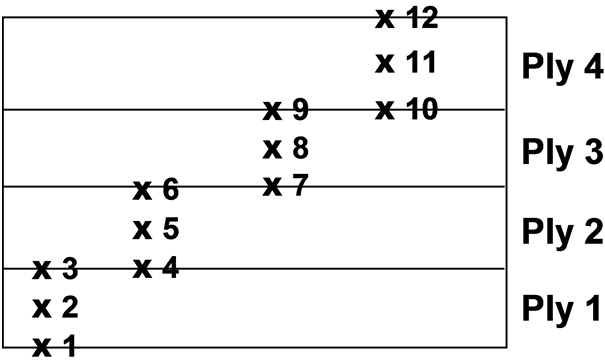Use a text editor to request output for the MCT state variables.
*ELEMENT OUTPUT S,E,SDV
It should be emphasized that the number of MCT state variables written to the output file depends on the number of state variables requested by the *DEPVAR statement (refer to the flow chart in the Request MCT State Variable Output for Composite Materials section).
When requesting output, consider the number and location of the section points where the output variables are calculated. In an element containing multiple material layers, the default section points correspond to the top and bottom surface of the element. Thus, the output variables are not available for any of the internal material layers. To view the output variables for each of the material layers within an element, you must explicitly list the section points where the output variables should be computed. As an example, consider a 4 ply composite plate with 3 section points per ply, for a total of 12 section points as shown in the image below. By default, the output variables are only computed for section points 1 and 12 corresponding to the top and bottom surfaces of the element. To view results for each material layer of the element, it is most practical to request that outputs be computed at the mid-surface of each material layer (i.e., section points 2, 5, 8, 11). To request specific section points for the calculation of output variables, add a data line immediately after the *ELEMENT OUTPUT keyword statement. This data line lists the specific section points where the output variables will be computed. For example, the following *ELEMENT OUTPUT keyword statement requests calculation of stress (S), strain (E) and the MCT state variables (SDV) at section points 2, 5, 8 and 11.
*ELEMENT OUTPUT 2,5,8,11 S,E,SDV

*ELEMENT OUTPUT 2,5,8,11,14,17,20,23,26,29,32,35,38,41,44,47 S,E,SDV *ELEMENT OUTPUT 50,53,56,59,62,65,68,71 S,E,SDV